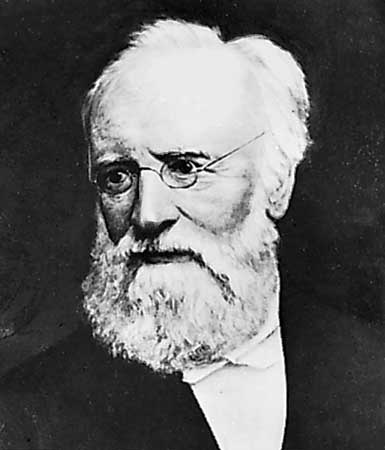Williamson, William Crawford
English naturalist
born , Nov. 24, 1816, Scarborough, Yorkshire, Eng.
died June 23, 1895, London
 English naturalist, a founder of modern paleobotany.
English naturalist, a founder of modern paleobotany.Apprenticed to an apothecary in 1832, Williamson, during his spare time, studied natural history and wrote several outstanding papers on fossils. In 1835 he was appointed curator of the museum of the Manchester Natural History Society. He left the museum to complete his medical training at University College, London, and then returned to Manchester, where he established his practice.
In 1845 Williamson initiated the study of deep-sea deposits when he wrote a paper on the microscopic organisms found in the mud of the eastern Mediterranean region. Between 1840 and 1850 he introduced a new technique for the study of marine protozoans (Foraminifera) and demonstrated plantlike characteristics of Volvox, which is a colonial protozoan. Six years later he was appointed professor of natural history, anatomy, and physiology at Owens College in Manchester. In 1880 he became professor of botany there, a position he held until 1892.
As a founder of paleobotany, Williamson demonstrated that certain fossils containing secondary wood (then considered a characteristic of the phanerogams, or seed plants and flowering plants) were really cryptogams (or lower plants without seeds or flowers, such as algae, ferns, and mosses). Williamson published this controversial material in the first of 19 memoirs gathered under the title On the Organization of the Fossil Plants of the Coal Measures (1872–94).
- Worrell, Sir Frank
- Worsaae, Jens Jacob Asmussen
- worship
- worsted knitting yarn
- Worth, Charles Frederick
- Worthenia
- Worthing
- Worthington
- Worthington Whittredge
- Worth, Irene
- Wotruba, Fritz
- Wottle, Dave
- Wotton, Sir Henry
- Wouk, Herman
- wound
- Wounded Knee
- Wouri River
- Wouwerman, Philips
- Wovoka
- Wozniak, Stephen Gary
- WPA Federal Art Project
- WPA Federal Theatre Project
- WPA Federal Writers' Project
- W particle
- Wrangel, Ferdinand Petrovich